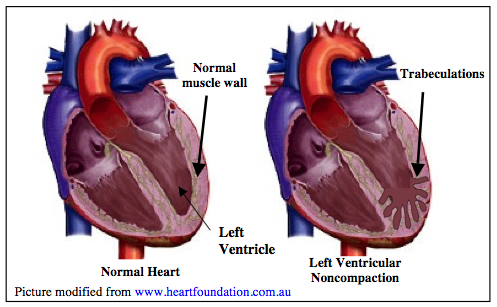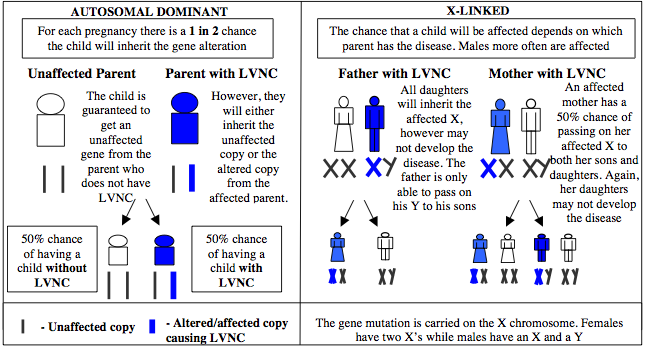What is left ventricular noncompaction (LVNC)? PDF version
Left ventricular noncompaction (also known as LVNC) is a disease of the heart muscle that has only recently been described. Left ventricular noncompaction can occur on its own (i.e. isolated) or along with other heart problems (i.e. congenital heart disease) and is characterised by deep trabeculations (finger-like projections) in the muscle wall of the left ventricle. These trabeculations can also occur in the right ventricle. The heart muscle abnormalities occur during the development of the heart in the embryo. Symptoms of the disease are variable; with some patients having no symptoms while others may develop shortness of breath, palpitations, chest pain, dizziness and fainting episodes. Occasionally the disease can cause heart failure, stroke (due to blood clots forming in the trabeculations then travelling to the brain) or sudden death.
It is not known how common left ventricular noncompaction is, although it is suspected to be relatively rare. There are generally two ages of presentation. The most common is during the first few years of life while other patients do not notice symptoms until adulthood. It is very important that everyone with a family history of left ventricular noncompaction be seen by a cardiologist for testing.
What causes isolated left ventricular noncompaction?
In many instances, left ventricular noncompaction is caused by abnormalities in our genes. Our body is made up of millions of cells. There are many different types of cells, including brain cells, liver cells and heart cells to name a few. Each cell contains 46 chromosomes, which hold the genetic material that decides features such as the colour of our eyes and whether we are tall or short. These 46 chromosomes are grouped into 23 pairs, one of each pair coming from mum and the other from dad. One of these pairs is known as the sex chromosomes, and these decide whether we are male or female. A female has two X chromosomes (XX) while a male has an X and a Y (XY).
If you imagine a chromosome as being like a ball of wool, you could stretch it out into one long strand, which is known as the DNA. Along the length of DNA there are regions called genes. As there are two copies of every chromosome, there are also two copies of every gene (as mentioned, one from each parent). Genes act as recipes to make certain things (proteins) in the body. If there is a mistake in one of these genes it may lead to the development of disease. This mistake is known as a gene alteration, and such mutations may be responsible for left ventricular noncompaction.
How is left ventricular noncompaction inherited?
Families with left ventricular noncompaction (LVNC) have been shown to pass the disease on in two different ways, via autosomal dominant or x-linked inheritance.
Autosomal Dominant Inheritance. This means that an affected person has a 1 in 2 (50%) chance of passing the gene alteration on to children and males and females are affected equally. Most inherited heart diseases are passed on in this fashion.
X-Linked Inheritance. This type of inheritance has so far only been observed in a small group of patients who develop left ventricular noncompaction during childhood. In this case the gene alteration exists in a gene located on the X chromosome (sex chromosomes determine gender, i.e. females XX, males XY). Therefore, a father with left ventricular noncompaction has a 100% chance of passing the gene alteration on to his daughters but no chance of passing it on to his sons. Alternatively, an affected mother has a 50% chance of passing the gene alteration on to both daughters and sons. A female who inherits the gene alteration may have less chance of actually developing the disease (i.e. may never develop the trabeculations) however can still pass it on to her children.
Rarely, a person may be the first in the family to have the mutation. In this case, brothers and sisters of that person are not likely to develop the disease, however children of the affected person are at risk of inheriting the gene mutation.
What is genetic testing?
Genetic testing involves looking for a mistake in the genes known to cause left ventricular noncompaction. At present, less than five genes have been identified to cause this disease and these genes are poorly understood.
The Agnes Ginges Centre for Molecular Cardiology, Sydney is carrying out research to both identify gene mutations in patients with left ventricular noncompaction and to understand how these gene abnormalities cause heart disease. In addition to the genetic studies, clinical and family information is also being collected to help understand more about this disease. If you would like to take part in this research program or would like more information, please call Ms Laura Yeates, Cardiovascular Genetics Research Coordinator (Ph: 02 95656187 or email: Laura Yeates).
Will a diagnosis of left ventricular noncompaction change my lifestyle?
Relatively little is known about the clinical aspects of left ventricular noncompaction. Based on the limited available information on this condition, following are some of the key recommendations we advise people when they are diagnosed with left ventricular noncompaction.
- Avoid competitive sports and strenuous physical activity: Competitive sports include those that require significant exertion, for example: touch football, basketball, netball, squash, running and even social games that you may not think are too strenuous. We recommend people avoid competitive sports because it may be associated with severe cardiac symptoms and possible sudden death.
- Regular light exercise: Although there is a lot of emphasis on avoiding sport, it is important to maintain a healthy lifestyle. Regular light exercise, such as walking, is not only good for your heart but also good for your general health.
- Regular check-ups with your cardiologist. It is important to monitor the progression of the disease and you should also report any new symptoms.
- Surgical procedures. You should inform the attending doctor that you have LVNC before any surgical or dental procedures.
- Consult with your GP or cardiologist before taking any new medications. It is important to talk to your doctor before taking any new medications, including over-the-counter (OTC) medications, complementary medicines, natural products and herbal remedies.
- Encourage relatives to be screened: As mentioned, first-degree relatives (parents, siblings and children) of an affected person have a 1 in 2 (50%) chance of also being affected. Screening of relatives involves them seeing a cardiologist where they will have a physical examination, an ECG and an echocardiogram (ultrasound of the heart) and possibly a magnetic resonance imaging (MRI) scan. The relative must inform the doctor there is a family history of LVNC to ensure no signs are missed. Find a specialist cardiac genetic service like the Genetic Heart Disease Clinics held at RPAH’s Sydney Heart Centre, RPAH (tel: 02 9517 2011). See our Cardiac Genetic Services Information Sheet to find your local service or speak to your regular cardiologist about screening family members.
The Agnes Ginges Centre for Molecular Cardiology carries out important research on left ventricular noncompaction and sudden cardiac death. Any donations towards this research would be gratefully received. Please contact Prof Christopher Semsarian if you would like to know more.
Contacts
If you have any further questions, there are many people you can contact. These include:
Ms Laura Yeates
Professor Christopher Semsarian
The Agnes Ginges Centre for Molecular Cardiology, Centenary Institute, Locked Bag No. 6 Newtown NSW 2042
Phone: (02) 9565 6187 Fax: (02) 9565 6217
Email Laura Yeates
Email Professor Chris Semsarian
Twitter @CSHeartResearch
Facebook Heart Registry





